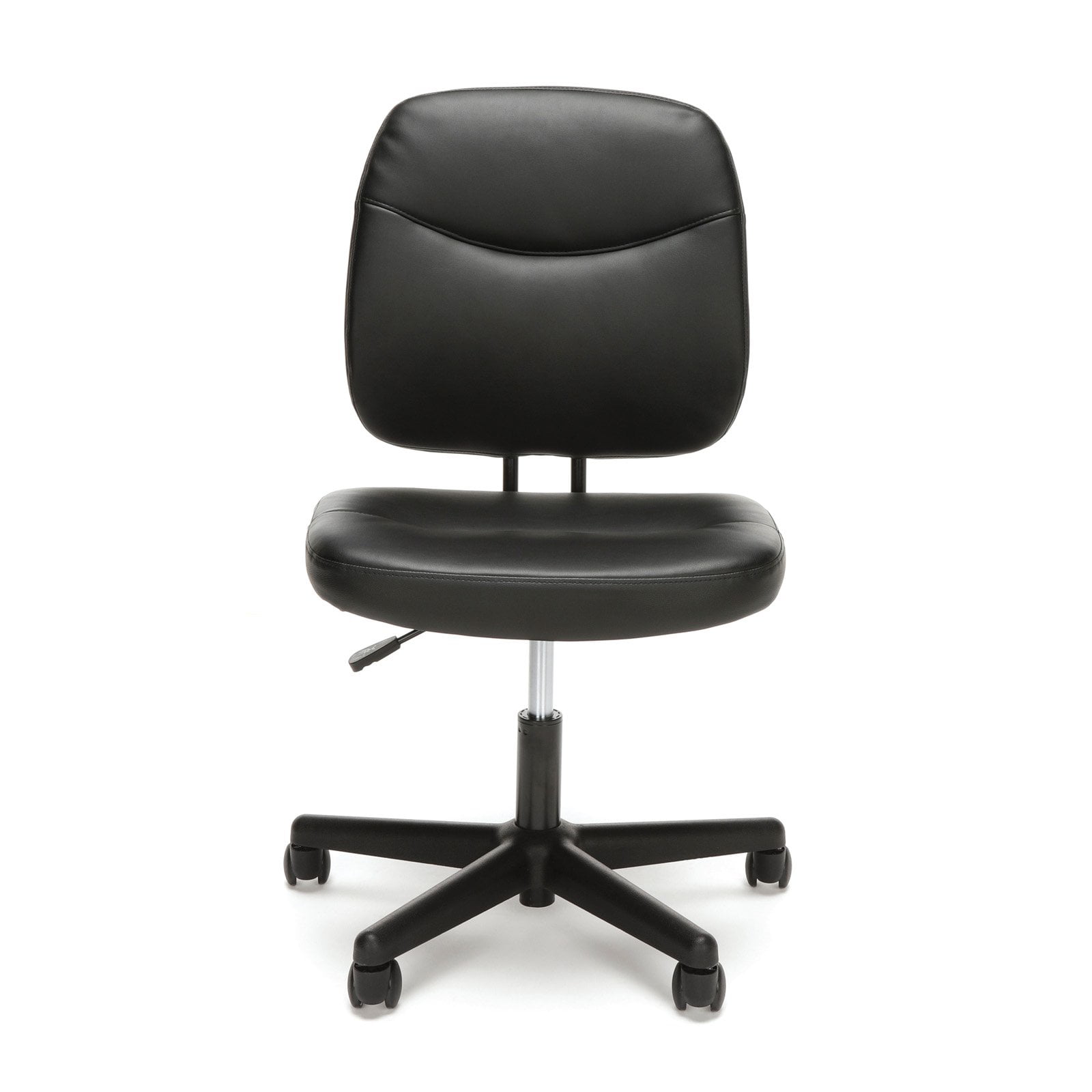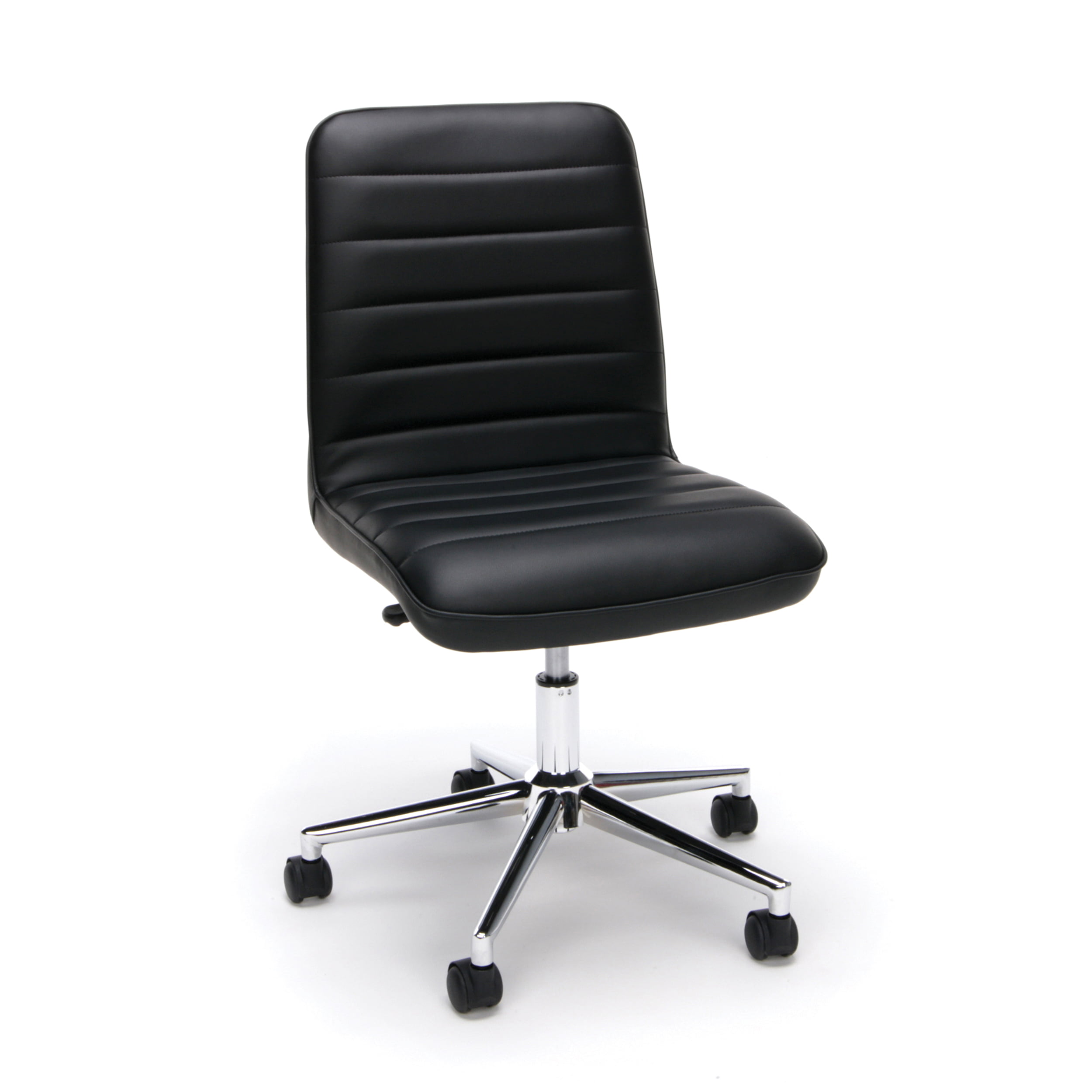Design & Aesthetics of Armless Leather Desk Chairs

Armless leather desk chairs offer a unique blend of comfort, style, and functionality, making them a popular choice for modern and traditional offices alike. Their sleek design contributes to a clean, uncluttered workspace, while the luxurious leather adds a touch of sophistication and elevates the overall aesthetic. The absence of arms provides greater freedom of movement and a more open feel, particularly beneficial for those who frequently shift positions or require easy access to their desk.
Design Styles and Suitable Environments
The versatility of armless leather desk chairs is reflected in their diverse design styles. From minimalist modern designs to classic traditional silhouettes, there’s a perfect option to complement any office setting. The following table illustrates the range of styles available:
| Style | Description | Material Variations | Suitable Office Environments |
|---|---|---|---|
| Modern Minimalist | Clean lines, simple silhouette, often featuring a sleek metal base and minimal stitching. | Smooth, polished leather in neutral colors (black, grey, white). | Contemporary offices, tech startups, minimalist home offices. |
| Mid-Century Modern | Inspired by the 1950s and 60s, characterized by organic shapes, tapered legs, and often a slightly curved back. | Leather in warm tones (browns, tans, mustards) with potentially visible stitching. | Retro-inspired offices, design studios, creative workspaces. |
| Traditional Classic | More ornate details, possibly including tufted backs or nailhead trim. Often features a more substantial base. | Leather in richer colors (deep browns, burgundy) with detailed stitching patterns. | Executive offices, law firms, traditional home offices. |
Impact of Different Leather Types, Leather desk chair no arms
The type of leather used significantly impacts the chair’s appearance, feel, and durability. Understanding the differences between full-grain, top-grain, and bonded leather is crucial for making an informed purchase.
Choosing the right leather is essential for both aesthetics and longevity.
- Full-Grain Leather: This is the highest quality leather, retaining the natural grain and markings of the hide. It is incredibly durable, develops a beautiful patina over time, and offers superior breathability.
- Pros: Durable, breathable, develops character, luxurious feel.
- Cons: More expensive, may show scratches and marks more easily.
- Top-Grain Leather: The top layer of the hide, with the natural grain sanded down for a smoother surface. It is less expensive than full-grain but still offers good durability.
- Pros: More affordable than full-grain, relatively durable, consistent appearance.
- Cons: Less breathable than full-grain, less character development.
- Bonded Leather: Made from leather scraps and polyurethane, it is the most affordable option. It mimics the look of leather but lacks its durability and breathability.
- Pros: Affordable, easy to clean.
- Cons: Less durable, not breathable, artificial feel.
Visual Descriptions of Armless Leather Desk Chairs
Let’s envision three distinct armless leather desk chairs:
Chair 1: The Minimalist Imagine a sleek, black leather chair with a polished chrome base. The leather is smooth, almost matte in finish, with minimal stitching visible only along the seams. The overall aesthetic is clean, modern, and sophisticated, ideal for a minimalist office or a tech professional.
Chair 2: The Classic This chair boasts a rich, deep brown full-grain leather with subtle variations in tone reflecting the natural markings of the hide. The back features a gentle curve, and the stitching is visible, adding a touch of traditional craftsmanship. The chair sits on a sturdy, dark wood base. This design appeals to professionals valuing timeless elegance and quality.
Chair 3: The Modern Retro Picture a chair upholstered in a warm, cognac-colored top-grain leather. The design incorporates mid-century modern influences with slightly tapered legs made of light-colored wood. The stitching is visible and slightly more prominent, adding a touch of visual interest. This chair’s versatility makes it suitable for creative individuals or those who appreciate a blend of classic and contemporary aesthetics.
Purchasing & Maintenance: Leather Desk Chair No Arms

Investing in an armless leather desk chair is a commitment to comfort and style. Understanding the pricing landscape and proper care will ensure your investment pays dividends in years of satisfying use. Let’s explore the factors influencing cost and delve into the secrets of maintaining your leather chair’s luxurious appeal.
Price Ranges of Armless Leather Desk Chairs
The price of an armless leather desk chair varies considerably, depending on several key factors. Leather quality, the reputation of the manufacturer, and included features all contribute to the final cost. Generally, you can expect a wide range, from budget-friendly options to high-end, bespoke pieces. The following table provides a glimpse into this range. Note that prices are approximate and can fluctuate based on retailer and sales.
| Brand | Model (Example) | Price Range (USD) | Key Features |
|---|---|---|---|
| Generic Online Retailer | Basic Leather Chair | $100 – $300 | Simple design, standard leather, basic construction |
| Mid-Range Furniture Brand (e.g., Flash Furniture) | Executive Leather Chair | $300 – $800 | Improved leather quality, ergonomic design elements, potentially adjustable height |
| High-End Furniture Brand (e.g., Herman Miller, Knoll) | Premium Leather Executive Chair | $800 – $3000+ | Top-grain leather, advanced ergonomic features, high-quality construction, potentially customizable options |
Cleaning and Maintaining a Leather Desk Chair
Proper care is essential for extending the life and beauty of your leather chair. Following these steps will help you keep your chair looking its best for years to come.
- Regular Dusting: Use a soft, dry cloth or a microfiber duster to remove dust and debris weekly. This prevents dirt from accumulating and damaging the leather.
- Spot Cleaning: Address spills immediately. Blot (don’t rub!) the affected area with a clean, damp cloth. For tougher stains, use a specialized leather cleaner following the manufacturer’s instructions. Avoid harsh chemicals or abrasive cleaners.
- Conditioning: Condition your leather chair every 3-6 months, or more frequently in dry climates. Leather conditioner helps maintain its suppleness and prevents cracking. Apply a small amount of conditioner to a clean cloth and rub it gently into the leather, following the manufacturer’s instructions.
- Protection: Consider using a leather protector spray to help repel stains and spills. Apply this according to the product’s instructions.
- Avoid Direct Sunlight: Prolonged exposure to direct sunlight can fade and dry out the leather. Keep your chair away from windows with strong sunlight.
Selecting Appropriate Chair Size and Height
Choosing a chair that fits your body and desk is crucial for comfort and posture. Consider these factors:
The ideal chair height should allow your feet to rest flat on the floor while your thighs are parallel to the ground and your knees are bent at a 90-degree angle. Your chair’s seat depth should allow for a couple of inches of space between the back of your knees and the seat’s edge.
To determine the appropriate chair height, measure the distance from the floor to the top of your thighs when sitting with your knees bent at a 90-degree angle. This measurement will provide a good starting point for selecting a chair. The chair’s seat height should ideally match this measurement.
For seat depth, measure the length of your thighs from the back of your knee to the back of your buttock. Add 2 inches to this measurement to ensure comfortable seating. Consider your torso length to ensure the chair back provides adequate lumbar support. If your desk is unusually high or low, you might need to adjust your chair’s height accordingly, or use a footrest to achieve optimal posture.
